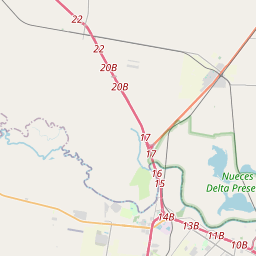Nuecestown (4 Miles North)
Historical marker location:






Henry L. Kinney (b. 1914), who founded Corpus Christi, established Nuecestown in 1852 at the location of the first ferry crossing on the Nueces River west of Corpus Christi. He sent agents to Europe, primarily England and Germany, to promote his new settlement. Each immigrant purchased 100 acres of land, a town lot, and 10 head of cattle.
Nuecestown, known locally as "The Motts" because of several clusters of trees, grew to have, in addition to the ferry, a hotel, packery, and one of the county's first cotton gins. A Post Office opened in 1859.
After the Civil War it was a gathering place for cattle drovers in the area herding longhorns to be driven to northern railheads. On Good Friday, March 26, 1875, Mexican bandits entered the region on a raid, causing many Corpus Christi residents to flee. After plundering the Frank Store (3 miles east), the raiders turned on Nuecestown, looting and burning T.J. Noake's store and Post Office, killing one man, and capturing several hostages. A party of citizens pursued the attackers unsuccessfully, and another man was killed.
When bypassed by the St. Louis, Brownsville and Mexico Railway about 1905, Nuecestown began to decline. The post office closed in 1927.
(1973)
As one of the most visible programs of the Texas Historical Commission (THC), historical markers commemorate diverse topics in Texas history, including: the history and architecture of houses, commercial and public buildings, religious congregations, and military sites; events that changed the course of local and state history; and individuals who have made lasting contributions to the state, community organizations, and businesses.
The University of Texas at Austin, founded in 1883, is one of the largest universities in the United States and has produced many notable alumni, including several U.S. presidents.
In 1828, the Mexican government granted land to Colonel Henry Lawrence Kinney, an American entrepreneur, who founded the trading post of Kinney's Trading Post near the Nueces River. This marked the beginning of Anglo settlement in the area. Nueces County was officially established in 1846, following the Texas Revolution and subsequent annexation of Texas by the United States.
Throughout the 19th century, Nueces County played a significant role in Texas' development. The town of Corpus Christi, which served as the county seat, became an important regional trade center due to its proximity to the Gulf of Mexico. The county flourished as a shipping hub for livestock, cotton, and other agricultural goods.
The county's history was greatly influenced by its participation in several military conflicts. During the American Civil War, Corpus Christi served as a center for Confederate forces, and the county witnessed both Union and Confederate occupation. Additionally, the county played an important role during World War II, with Corpus Christi becoming a major training center for Navy pilots.
In recent times, Nueces County has continued to grow and evolve. The county's economy has diversified, with tourism, oil and gas, and the military being major contributors. The region boasts numerous attractions, including beautiful coastal beaches, cultural sites, and a vibrant culinary scene. Today, Nueces County remains an important and thriving part of Texas' history and economy.
Nueces County Timeline
This timeline provides a condensed summary of the historical journey of Nueces County, Texas.
- 1836 - Nueces County is established as one of the original counties in the Republic of Texas.
- 1845 - Texas becomes a state of the United States, and Nueces County remains part of the state.
- 1848 - The county seat is established in Corpus Christi.
- 1850 - The population of Nueces County reaches 756 residents.
- 1852 - The Corpus Christi Cathedral is constructed, becoming a significant landmark in the county.
- 1872 - The railroad reaches Nueces County, leading to increased economic development and population growth.
- 1875 - The Nueces County Courthouse, built in the Renaissance Revival style, is completed.
- 1900 - A devastating hurricane strikes the county, causing significant damage and loss of life.
- 1914 - The Port of Corpus Christi is established, becoming a major hub for trade and industry.
- 1931 - The Nueces County Courthouse is expanded and remodeled to its current appearance.
- 1940 - Nueces County experiences a population boom, with the county's residents totaling over 101,000.
- 1987 - Hurricane Gilbert causes widespread destruction in Nueces County and the surrounding areas.
- Present - Nueces County continues to be a thriving center for commerce, industry, and tourism.